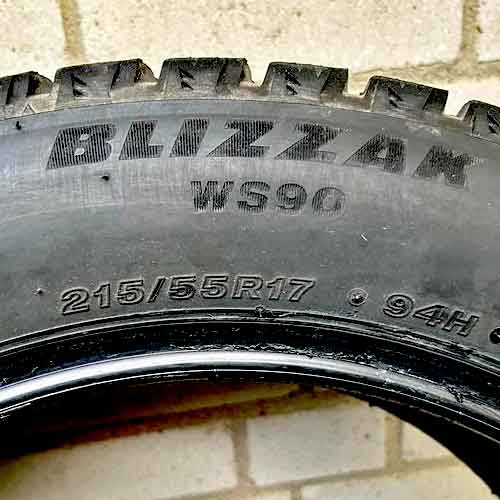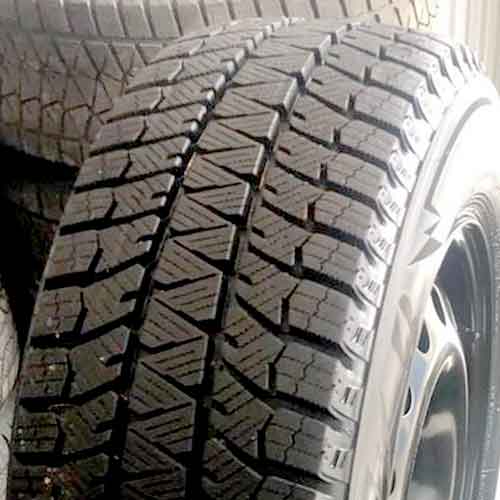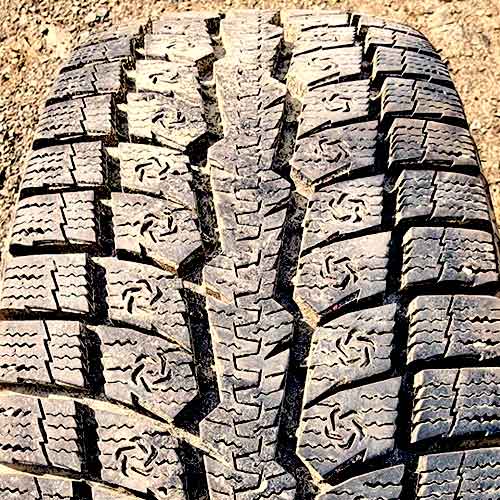The Toyo Observe GSI 6 equipped with an innovative tread compound for optimal grip, squares up against the Bridgestone Blizzak WS90, with its superior multi-cell compound. Who will emerge victorious in this showdown of the snow?

Table of Contents
Info on Sizes
The Blizzak WS90 (review) comes in 52 total sizes in 15 to 19 inches (wheels) with following specs.
- Speed ratings: T or H.
- Load ratings: SL or XL.
- Tread depth: 11 or 12/32″.
- Weight: 17 to 29 lbs.
- Tread warranty: None.
On the other side, the Toyo Observe GSI 6 comes in 14 to 22″ with following.
- Speed ratings: H and V.
- Load ratings: SL and XL.
- Tread depth: 11 to 12.6/32″.
- Weight: 17 to 41 lbs.
- Tread warranty: None.
Tread Structure
The Bridgestone Blizzak WS90 is a tough winter tire with a special design on the surface, or tread. Let’s look more closely at its parts.

So on the tread, you’ll notice three sections, or ‘ribs. The one in the middle is continuous running, so there aren’t any proper blocks there. Though you do get a lot of tread features there, nonetheless.
So besides a lot of wave like siping, you also get small cuts or slits here, which get wider as they reach the edges.
They then join with V-shaped notches that look like teeth, or “biters”, which help with traction a lot.
This also goes for the lateral notches on the shoulder lugs. These combined with the longitudinal slits (in the middle of these lugs), yield amazing traction values.
Moreover, these shoulder blocks also have zigzag slits running along near the edges of the tire. And like other winter tires, you get a ton of siping here as well.
On the other hand, Toyo Observe GSI 6 also features a directional pattern.

Looking at its tread, we can see it has three parts, or ribs, (consider them columns of blocks in the middle).
So these 3 create 4 longitudinal channels, of equal width, though the outer ones are more biting.
The central-most rib is made continuous, as its not divided all the way by those slits you see.
And they are a lot, they make zigzag pattern all along.
Moreover, you can also see sharp notches and a mixture of rectilinear and interlocking siping on this rib.
The surrounding ribs are open, forming interconnected grooves, and these have a ton of biters.
You can see the snow-vices facing the shoulders, then you can see multiple notches, and off-set edges, along with siping. And yes, you can not miss the flower/snowflake shaped deep incisions.
The shoulder lugs also have the same story. They have snow-vices, zigzag slits in the middle, and of course wave-like siping.
Snow Performance
When discussing performance in soft snow, the Toyo Observe GSI 6 manages to nudge ahead slightly, because it features more gaps/biters, which essentially function to trap snow particles, enhancing snow-to-snow contact.
The trapped snow, basically, creates the contact patch with the ground as the tire spins, fostering improved traction. And this occurs because snow bonds more effectively to itself than to rubber.
Moreover, with the tire’s tread having a directional pattern, you also get a paddling effect, where snow is scooped and thrown backwards, and forward momentum is created.
The Blizzak WS90 on the other hand is missing with both of these features. It’s pattern is symmetric, and it doesn’t offer as effective of a snow to snow contact.
Wet Traction
Wet traction is largely influenced by two factors: tread configuration and rubber formulation. These in turn determine the tire’s grip and resistance to hydroplaning, the two dimensions of wet performance. Let’s dive into each one.
Wet Grip
Even though both these tires feature abundant siping and flexible tread rubber, the Blizzak is still overall lacking here.
So why is that?
Well because the WS90, although features numerous biters, they are still not as abundant when seen alongside with Toyo Observe.
The Toyo’s central rib can be seen with zigzag longitudinal slits, along with an array of rectilinear and interlocking sipes, along with notches. Moreover, you can also see snowflake shaped slits on the surrounding blocks, along with snow vices facing the shoulders (which by the way also have those, apart from zigzag slits).
All of these provide much better water absorption capabilities.
Basically these tread voids expel/blow out air, when meeting with the surface, essentially creating a type of vacuum, which allows for a suction, soaking water particles ability.
And with more in number of these voids/biters, you get a superior performance on Toyo GSI 6.
The Blizzak WS90 on the other hand, although also features dual siping design, and multi-angled biters, it’s performance still takes the back seat, as the tire shows up slightly longer handling lap times (on average).
So overall in case of wet girp, you get a supeiror performance on Observe GSI 6
Side Note: All of these features which make Toyo better here, also can be used to explain its more commendable ice traction performance too.
Hydroplaning resistance
Hydroplaning is a phenomenon that occurs when water forms a barrier between the tire tread and the underlying surface.
This “barrier” effectively causes the tire to levitate slightly, resulting in a complete loss of traction, which is a significant safety hazard.
And so when it comes to this aspect, the Toyo Observe GSI-6 takes center stage with an impressive performance.
Its wide channels, coupled with sweeping arms, permit increased average hydroplaning speeds.
This holds true for both straight and curved aquaplaning scenarios.
Furthermore, its elaborate maze of channels is designed to efficiently disperse water in all directions, contributing to an overall superior hydroplaning resistance.
So overall hydroplaning resistance is seen better on Toyo GSI 6.
Tread Life
Tread life is significantly impacted by rolling resistance, which is a function of the tire’s weight and rubber composition.
So it’s logical that the Toyo Observe GSI 6 falls short in this area as well.
The tire’s heavier weight exerts increased stress on the tread, and since the lugs are more spaced apart, each lug has to endure more weight pressure, as they grind against the road with greater force.
Indeed, the tire’s relatively softer rubber compound exacerbates this situation.
In contrast, the Blizzak WS90 benefits from being lighter and having closely-packed lugs, which encounter less friction as the tread contacts the road.
So overall treadwear is seen faster on Toyo.
Comfort Levels
Tire comfort is primarily influenced by factors such as the level of road noise and the ability to absorb vibrations.
Speaking of noise first, which basically originates from the collision of air particles against the walls of the tread, you get a lacking performance on Toyo. As simply put, the wider the tread voids, the higher the noise produced.
And Toyo GSI 6 with relatively spacious tread design falls short in keeping the ride quiet.
Contrastingly, when we venture into the realm of shock absorption, the Toyo Observe GSI-6 outshines its counterpart, the Blizzak WS90.
Due to its softer tread compound, this tire is exceptionally well-suited to cushion shocks, ensuring a smoother ride overall.
Fuel Economy
Tire fuel efficiency is fundamentally linked to tread design and structural weight. These things basically tell you about the rolling resistance.
For the sake of simplification, the tire’s greater weight, coupled with larger tread voids, contribute to increased lug flexing during cornering, braking, or accelerating.
And this flexing or molding of the lugs results in extra energy consumption, which is exactly what we see on Toyo Observe GSI 6.
On the other side, the Blizzak WS90, equipped with more streamlined, longitudinally aligned ribs, doesn’t generate as much rolling resistance, so you get a better MPG here.
Dry Traction
Dry traction can be divided into two parts: directional grip and handling. Let’s examine each one.
Directional Grip
Dry grip is dependent on the central area of the tread since it forms the most contact with the ground, especially when it comes to winter tires, given their rounded contact patch and directional design, for the most part.
Hence, in this case, the Bridgestone Blizzak WS90 emerges victorious, as it features a “wider” continuous-running central rib, ensuring an uninterrupted connection between the rubber and the road.
This results in superior braking distances, indicative of directional grip.
In contrast, Toyo Observe GSI 6 falls short with its broader tread voids, and narrower central rib (however continuous).
Handling
A tire’s cornering abilities or overall sideways traction depends on its shoulder lugs.
Here, two things are evaluated.
First, how effectively these lugs connect with the ground as the tire rotates.
And second, the extent to which these lugs bend during this process.
And in both aspects, the Blizzak WS90 outperforms its counterpart.
Its compact pattern forms a larger contact with the ground, and due to its lighter weight, its lugs don’t tend to flex too much as the tire corners.
During cornering, most of the tire’s weight shifts towards the shoulders, and their bending disrupts the balance between oversteer and understeer, resulting in a slower steering response.
Therefore, with heavier structures and broader channels, the Toyo Observe GSI 6 displays longer handling lap times.
To Conclude
Both premium winter tires are very notable, with each excelling in different areas.
The Observe GSI-6 shows superiority in wet traction and soft snow performance, thanks to its abundant sipes and tread voids. However, its wider grooves compromise comfort by increasing road noise.
Conversely, the Blizzak WS90 shines in dry traction and fuel economy due to its continuous central rib and lighter weight, but it lacks hydroplaning resistance.
Moreover, despite their unique advantages, the Observe GSI-6 suffers quicker treadwear, while the Blizzak WS90 offers a smoother ride, illustrating that each tire serves specific needs depending on driving conditions.